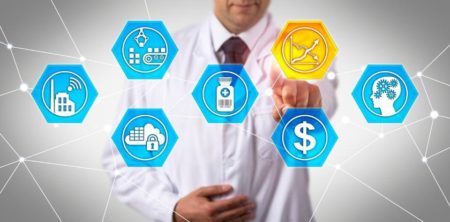While the healthcare sector has lagged behind others in becoming a data-powered industry, rapidly changing trends in the industry are creating the environment for change and innovation. From pharmaceutical testing to patient care, monitoring contagion spread to genetic testing, there are opportunities in this post-big data era to leverage new data sources for improved outcomes. It is now possible for healthcare and life science organizations to apply fast, actionable analytics to the following:
- Drug Discovery
- Precision Medicine
- Point of Care/Patient 360
- Insurance Fraud

Next-generation solutions, such as GPU-accelerated databases like Kinetica, are reshaping the pharmaceutical and healthcare industries.
Benefits in all four of these areas can be lifesaving.
-
Drug Discovery and Development
Bringing new drugs to market is an expensive, lengthy, laborious, and risky process requiring billions in upfront investments with low success rates. Researchers now can use algorithmic techniques such as machine learning with easy-to-use visual analytics tools to interactively run thousands of simulations across complex data sets and find signals in the noise. By doing so, pharmaceutical companies accelerate drug discovery, development, and the clinical trials process while reducing risks, minimizing costs, and ultimately saving lives.
For example, a global healthcare company that saw the promise of NVIDIA (NVDA) GPU-accelerated computing made a sizable investment in order to accelerate chemical simulations for drug discovery, research, and development. They were then able to take advantage of advanced, fast analytics and machine learning for broader analysis.
-
Precision Medicine
Precision medicine is the identification of approaches that will be effective for specific patients based on genetic, environmental, and lifestyle factors. In clinical research, information sets are so large and complex that it can be difficult for researchers to analyze this extreme data to determine what types of treatments patients will respond to. Precision medicine not only aids in providing patients with the best care, but also helps reduce costs by avoiding ineffective treatments for individual patients.
In addition, a GPU database within an instant insight engine for analytics can be used in genomics to develop safe and effective medications and dosages tailored to variations in people’s genes. To more accurately predict drug targets, researchers can analyze transcriptomics (the study of biomarkers to assess drug safety and chemical risk) and identify new genome signals.
-
Patient 360
The patient experience and quality of care can only improve when all patient data is available for analysis and timely intervention can adjust treatments before a crisis occurs. Unfortunately, most providers have a big challenge dealing with not just the collection of patient data, but also its immediate analysis.
This is particularly true in many healthcare organizations that are limited by the speed of data processing. In addition, hospitals find it difficult to scale up to process real-time data and unpredictable data sources. A modern GPU-based insight engine enables hospitals and healthcare organizations to easily scale to meet growing data volume requirements in the Internet of Things (IoT). According to Standard Medicine, “The growth seen in medical data (by some estimates 48% each year), computing power and technical ability are enabling the medical field to reinvent itself in ways never before possible. Data doesn’t do you any good until you can turn it into information, and that is really our challenge.” Data about a patient from different systems and IoT medical devices needs to be analyzed immediately to provide proactive care.
By ingesting and performing real-time analysis on streaming data from health monitoring devices and other medical equipment, physicians get real-time visibility into their patient’s status. With added geospatial data and visualization, they can instantly see locational and time-based changes, among others. A leading healthcare organization applies spatial analytics and map-based visualizations to data sourced from its electronic medical records and from publicly and commercially available datasets. The results help them understand the health needs of their members in the context of their communities. It helps them better respond to community needs, and in many cases, provide transformative care in treating chronic conditions such as diabetes, cardiovascular disease, and respiratory illness.
-
Insurance Fraud
Healthcare fraud costs billions of dollars every year in the United States alone. During Fiscal Year (FY) 2016, the Federal Government won or negotiated over $2.5 billion in healthcare fraud judgments and settlements. As a result of these efforts, as well as those of preceding years, in FY 2016 over $3.3 billion was returned to the Federal Government or paid to private persons. It is difficult to keep detection models up to date as fraud techniques continue to evolve at a very rapid pace. In addition, traditional methods for detecting healthcare fraud and abuse are time-consuming and inefficient. By creating a visual mapping of patients, providers, pharmacies, and claims to identify groups of actors or claims that may indicate unusual behavior, payers can detect fraudulent claims and assess member risk.
Next-generation solutions, such as GPU-accelerated databases like Kinetica, are reshaping the pharmaceutical and healthcare industries. With a fast and powerful data and analytics solution, pharmaceutical and healthcare companies are accelerating drug discovery, improving precision medicine, delivering patient 360, and combating fraud – improving healthcare for us all.
This article was originally published on Forbes on 5/30.
Michael Mahoney is VP WW Solutions Engineering at Kinetica.

